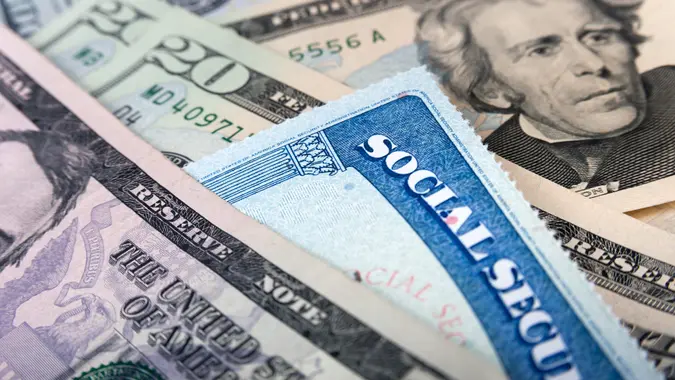How Much Your Child Would Have for Retirement If They Contribute To a Roth IRA Immediately

Commitment to Our Readers
GOBankingRates' editorial team is committed to bringing you unbiased reviews and information. We use data-driven methodologies to evaluate financial products and services - our reviews and ratings are not influenced by advertisers. You can read more about our editorial guidelines and our products and services review methodology.

20 Years
Helping You Live Richer

Reviewed
by Experts

Trusted by
Millions of Readers
A Roth IRA can be a great retirement account for nearly everyone, but it’s especially valuable for younger investors. This is because contributions to a Roth IRA are made on an after-tax basis, meaning investors don’t get a tax deduction for money they put into the account. But as your child is likely in an extremely low tax bracket — if they even owe any taxes at all — that drawback doesn’t really apply. Meanwhile, they’ll get to enjoy tax-free withdrawals from the account in retirement.
But how much could a child really earn by the time they retire if they start contributing to a Roth IRA while they are still young? Here’s a look at how much your child might have for retirement if they contribute various amounts to a Roth IRA at age 16 and 18, based on hypothetical investment returns.
Age 16
Sixteen is the age at which many kids pick up their first jobs, such as working at a local retail store. As long as a child has earned income that they can document via a tax form like a W2 or 1099, they are eligible to contribute to a Roth IRA.
Contributing $50 Per Month
Most 16-year-olds aren’t yet in the habit of setting aside money every month to contribute to a retirement plan, and most don’t earn tens of thousands of dollars per year. That’s why it’s usually a good idea to start out slow when your child starts earning his or her first paycheck. Setting aside just $50 per month may be a good way to get them in the practice of saving and investing while still allowing them to learn other money management skills, such as budgeting and managing splurges.
But at such a young age, contributing even a modest amount to a Roth IRA can pay big dividends over the long run. In fact, the earlier your child can invest, the less they’ll have to put in over their lifetimes to earn a sizable retirement payout. This is due to the powerful effects of compound interest over long periods of time.
Imagine, for example, that your 16-year-old contributes just $50 per month to a Roth IRA and earns an average annual return of 8%. By the time they reach age 65, their Roth IRA could be worth $365,619. At a 10% average annual growth rate — which approximates the long-term average of the U.S. stock market — that nest egg could be closer to $783,000.
Maxing Out Roth Contributions
For 2024, if your child wants to max out their Roth IRA contributions, they’ll have to kick in $7,000 per year, or about $583.33 per month. No one can contribute more to their Roth IRA than they actually earn, so your child will have to pull down a decent paycheck to fully fund a Roth IRA. However, as wages have been rising in recent years, it’s entirely possible that a teenager could earn at least $7,000 even just working over the summer months.
At that level of contribution, retirement earnings can absolutely explode by age 65. An 8% average annual return will result in an account balance of about $4.27 million, while a 10% annual return will boost that balance closer to $9.1 million.
Age 18
Waiting until age 18 to contribute to a Roth IRA will result in lower account balances at age 65, but they’ll still be impressive.
Contributing $50 Per Month
At a modest contribution level of $50 per month, an 18-year-old will see their account balance grow to over $310,000 by the time they reach age 65. At a 10% annual earnings rate, that balance will more than double, to about $641,000.
Maxing Out Roth Contributions
Maxing out Roth IRA contributions starting at age 18 can result in an age-65 balance of over $3.6 million, assuming an 8% annual growth rate, or $7.48 million with a 10% annual return.
Caveats
Nothing moves in a straight line in the investment world. Although an average annual return of 8% or 10% may result in the account balances shown above, the sequence of returns an investor earns can play a big role in the final value of a Roth IRA.
For example, imagine you invest $1,000 into a Roth IRA and earn 10% per year for four years. You’ll end up with an account balance of $1,464.10. But if you instead earn returns of 20%, 20%, 20% and -20% over those four years, you’ll still have an average annual return of 10%, but your account balance will be $1,382.40. Over time, these variances can add up, so it’s important to note that the balances shown above are for illustrative purposes only.
Another factor to consider is that the maximum allowable contribution to a Roth IRA will increase over time, more or less in line with inflation. If your child can continue to increase their contributions throughout their lifetime, their long-term returns will likely increase accordingly.
The bottom line is that the earlier that your child can contribute to a Roth IRA — and the more they can sock away — the larger their account balance will be by the time they retire.
 Written by
Written by  Edited by
Edited by 
























